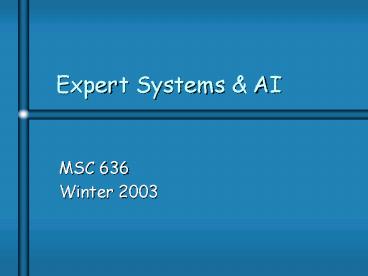Expert Systems - PowerPoint PPT Presentation
1 / 16
Title:
Expert Systems
Description:
Interpretation of instincts, ideas, rules, relationships, procedures, ... Improved algorithms (Rete) Learning (self-evolving) Biological analogies, ANN, GA ... – PowerPoint PPT presentation
Number of Views:74
Avg rating:3.0/5.0
Title: Expert Systems
1
Expert Systems AI
- MSC 636
- Winter 2003
2
What is Knowledge?
- Data
- Facts, measurements, or observations
- Specific accuracy
- Information
- Data organized to be useful relevant for a
particular problem - Personal relevance for problem
- Knowledge
- Interpretation of instincts, ideas, rules,
relationships, procedures, information about a
particular problem domain - Evolves understanding of domain
3
Knowledge-based DSS
- Knowledge is everything you need to know to help
solve groups of problems within a domain a
mental construction more abstract dynamic than
information - Holsapple Whinston (1988)
- Declarative (descriptive) knowledge
- Procedural knowledge
- Reasoning knowledge
- Knowledge is implicit or explicit (or both)
4
Variable emphasis on knowledge, data, or models
5
Artificial Intelligence
- Artificial intelligence is supportive CS research
domain - Enable computers to simulate the reasoning
processes performed by humans - Intersection of computer science cognitive
psychology - Human reasoning processes
- Categorization
- Rules heuristics
- Past experiences
- Expectations
6
AI vs. Traditional Computing
- AI differs from conventional computing
- Reasoning (inferencing)
- Rule-based heuristic logical systems
- Pattern recognition
- Voice, fingerprints, faces, signatures
- Improved algorithms (Rete)
- Learning (self-evolving)
- Biological analogies, ANN, GA
- Classification categorization
- Handles incomplete data/linguistic ambiguities
- Fuzzy logic
7
Expert Systems
- Knowledge-driven DSS common in business
applications - Expert-derived rule-based knowledge base
- Database stores facts (temporarily stored in
workspace/blackboard) - Knowledge base stores relationships rules
- Inference engine processes facts rules directs
processing (reasoning) - Interface manages communication with user
8
A Typology of Expert System Tasks
- Interpretation Infer situation descriptions and
meaning from sensed inputs - Prediction Forecasting likely consequences of
actions given certain input values - Diagnosis Inferring faults/diseases based on
interpretation of data - Planning Suggest actions and plans to achieve
stated goals - Design Configuring object specifications for
satisfying input requirements - Prescription Prescribing remedies and treatments
for malfunctions/diseases - Monitoring Comparing sensory/user inputs to
expected outcomes - Control Governance of overall system behavior
- Instruction Diagnosis, prescription, and
guidance of user behavior intelligent computer
assisted learning
9
ES Inferencing (rule-based)
- Control cycle
- Match
- Select
- Execute rules
- Store facts
- Facts
- Known/deduced events or conditions, entered by
user or deduced by system
- Rule examples
- Modos ponens
- If A then D
- Given A is true
- Deduce that D is true
- Modos tollens
- If B then (necessarily) C
- Given C is not true
- Deduce that B is not true
10
Inferencing Method
- Chaining--gtorganizing rules so that deduced fact
from one is premise for the next - Forward inductive, data-driven start with facts
we know build toward goal - Backward deductive, goal-driven, most commonly
used in ES - Choice of method based on
- Expert reasoning preference
- Efficiency
- Backward few goals or possible outcomes many
known facts - Forward many goals or possible outcomes few
known facts
11
MYCIN
- 1970, Stanford, infectious agent identification
- Features
- Rule-based knowledge representation
- Probabilistic rules certainty factors
- Backward chaining inference logic
- Explanatory (questions results)
- User friendly interface
12
MYCIN example
- MYCIN What is the infection?
- USER Endarteritis
- MYCIN Is organism a rod or a coccus?
- USER Rod. . . .
- MYCIN Organism is E. coli
- USER How did you decide the organism is E.
coli? - MYCIN I used rule 084 to make conclusion. This
gave a cumulative certainty factor of 0.51
13
Development of ES
- Task modeling
- Nature of problem, identify experts
- Performance modeling
- Knowledge acquisition and validation
- Interview experts/verbal protocal analysis/other
techniques - Research documentation
- Compare multiple sources
- Knowledge representation
- Knowledge engineer/analyst
- Decision trees/inference tables/rule lists
- Model uncertainty (rules probabilities)
- Prototyping
14
Validation Verification
- Knowledge base validation
- Marcot Table 8-5, pg. 254
- Characteristics of high quality knowledge base
- Responsibility of expert KE
- System verification
- Does the expert system accomplish its objectives?
- Systems analyst responsibility
15
Benefits
- Faster decisions
- Access to expert knowledge
- Increased productivity of experts
- Consistency
- Understanding
- Build organizational knowledge
16
Limitations
- Knowledge to build is not available, difficult to
extract - Logic may defy coding
- Humans are more flexible adaptive
- ES have limited sensory capabilities
- Human bias still a problem
- Social problems
- May be more error prone expensive to develop
build































